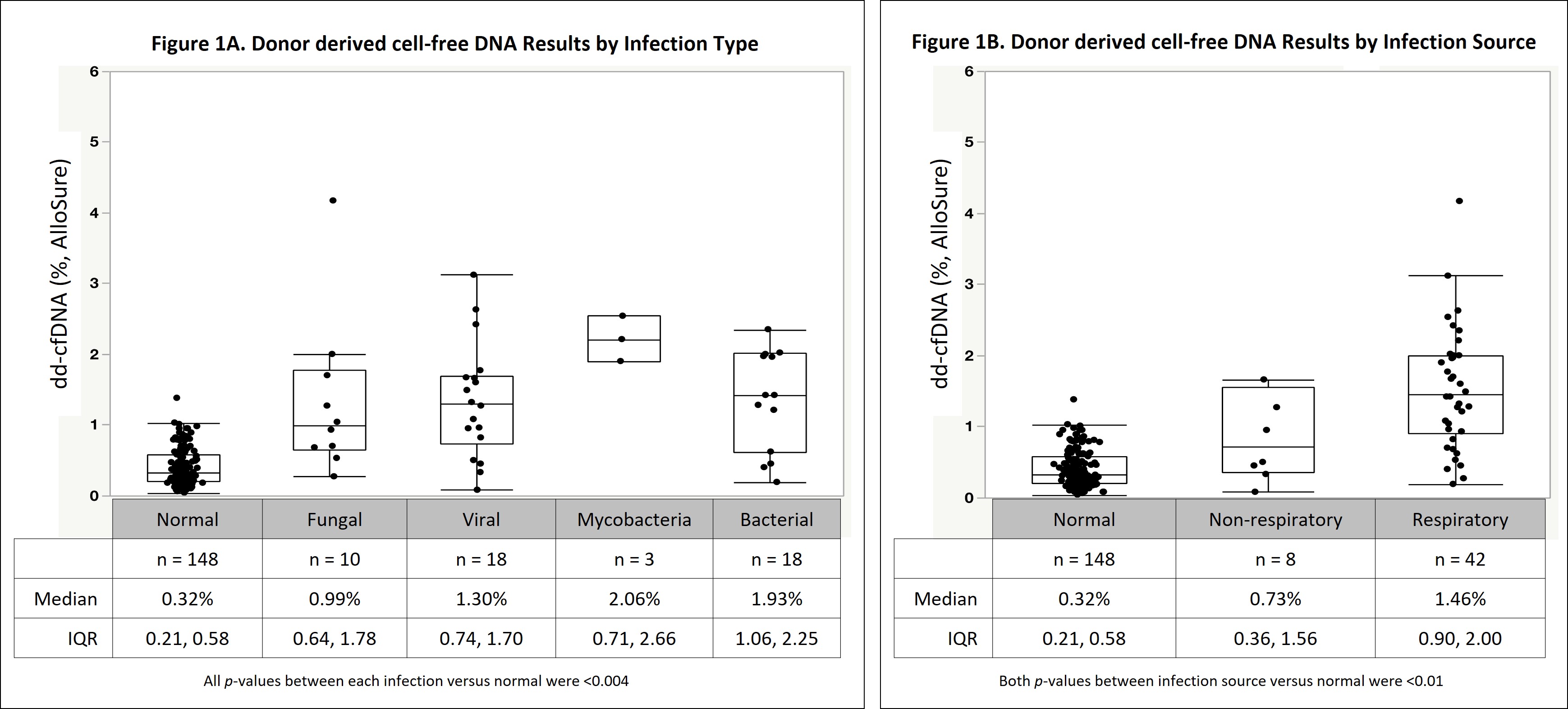Infection Impacts dd-cfDNA in Lung Transplant Recipients
1University of Texas Health System San Antonio, San Antonio, TX, 2CareDX, South San Francisco, CA, 3Pneumology, Adult CF Center and Lung Transplantation Department, Foch Hospital, Suresnes, France
Meeting: 2022 American Transplant Congress
Abstract number: 48
Keywords: Genomic markers, Infection, Lung, Non-invasive diagnosis
Topic: Clinical Science » Lung » 64 - Lung: All Topics
Session Information
Session Name: Infectious Considerations for Lung Transplantation
Session Type: Rapid Fire Oral Abstract
Date: Sunday, June 5, 2022
Session Time: 3:30pm-5:00pm
 Presentation Time: 4:40pm-4:50pm
Presentation Time: 4:40pm-4:50pm
Location: Hynes Room 210
*Purpose: Infection is the leading cause of death within 1 year post lung transplant. Graft injury secondary to infection is affected by both source and organism. Donor derived cell-free DNA (dd-cfDNA) is a consistent marker of graft injury, but previously reported dd-cfDNA levels with infections have been inconsistent. We compared dd-cfDNA concentrations across different infection types.
*Methods: We reviewed infections in lung transplant recipients (LTR) between 5/2019-6/2021 with paired dd-cfDNA at time of infection. All were confirmed infections (i.e. requiring therapy). Infection source (respiratory vs non-respiratory) and organism were collected. Samples were excluded if there was concurrent ACR, AMR or CLAD at time of dd-cfDNA. The primary endpoint was dd-cfDNA levels across cohorts.
*Results: Fifty paired samples from 20 LTR were identified; 31 samples were excluded due to concurrent diagnoses. Infections included viral (n=18, 36%), bacterial (n=18, 36%), and fungal (n=10, 20%). Four cultures (8%) had multiple organisms. Most common within each group were CMV (n=4) and COVID (n=4) for viral, Pseudomonas aeruginosa (n=4) for bacterial, and Aspergillus (n=7) for fungal. Median dd-cfDNA was 1.30% in viral infections, 1.93% in bacterial, and 0.99% in fungal; respiratory infections (n=42) was 1.42% and 0.95% in non-respiratory (n=8).
*Conclusions: There was a statistically significant increase in dd-cfDNA between each infection compared to a normal cohort, but no statistical differences between infection groups. The trend towards significance of respiratory vs non-respiratory indicates that dd-cfDNA may be a useful marker of injury specific to the graft caused by infection. Further investigation with serial samples prior to and following treatment of the infection will be important to better understand this trend.
To cite this abstract in AMA style:
Levine D, Giner C, Pham C, Woodward R, Roux A. Infection Impacts dd-cfDNA in Lung Transplant Recipients [abstract]. Am J Transplant. 2022; 22 (suppl 3). https://atcmeetingabstracts.com/abstract/infection-impacts-dd-cfdna-in-lung-transplant-recipients/. Accessed December 12, 2025.« Back to 2022 American Transplant Congress

